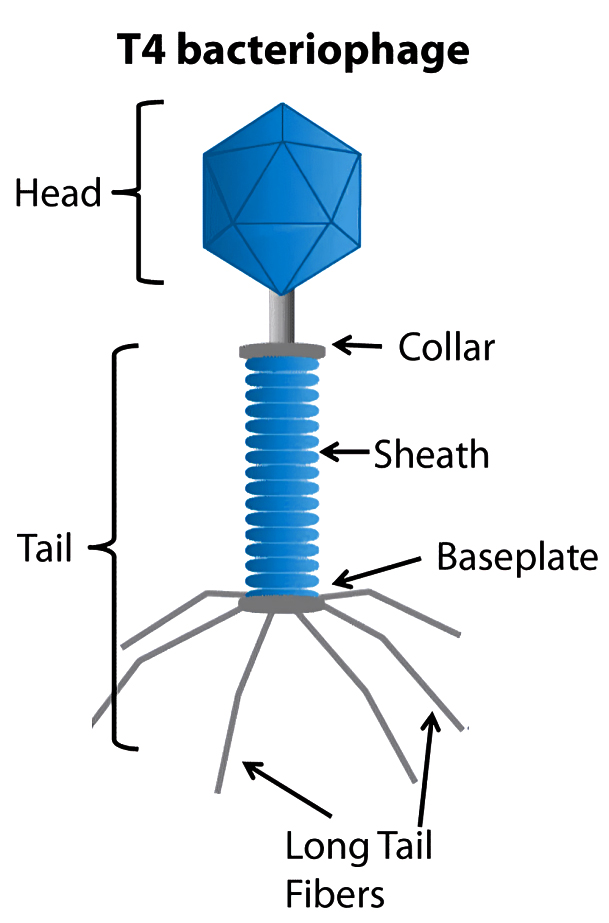
Bacteriophage: Bacteriophages are viruses that infect and reproduce within bacteria. They are found in environments like soil and water. Bacteriophages attach to bacterial cells, inject their genetic material, and hijack the host's machinery to make more viruses. This can lead to the bacterial cell bursting open. Bacteriophages vary in genetic makeup and shape, with some having tail-like structures. They follow two primary life cycles: lytic, causing cell destruction, and lysogenic, integrating into the bacterial chromosome. Bacteriophages are studied in molecular biology and offer potential in agriculture and medicine as biocontrol agents and alternatives to antibiotics. Read the NEET Biology Notes below to learn more details about the bacteriophage.
What is Bacteriophage?
Bacteriophages are viruses specialized in infecting and reproducing within bacteria. The term "bacteriophage" originates from Greek, where "bacteria" (bakterion) means bacteria and "devourer" (phagein) signifies their consuming nature. These viruses engage in a fascinating symbiotic relationship with bacteria. It seizes control of the bacterial cellular machinery to replicate and generate more phages. Bacteriophages contain genetic material, either DNA or RNA, enclosed in a capsid protein coat. Some phages possess a tail-like structure called a tail sheath. It aids in attaching to specific receptors on the bacterial cell surface and delivering their genetic material inside the host cell. Once inside the bacterial cell, the phage's genetic material takes control of the host cell's machinery, which causes it to produce more phage parts. Eventually, the bacterial cell opens and releases new phages to infect nearby bacteria. This process, called the lytic cycle, rapidly reduces the bacterial population.Bacteriophage Classification
Bacteriophages are categorized based on two main characteristics: their genetic material (DNA or RNA) and their morphology (shape).- DNA Phages : These bacteriophages contain DNA as their genetic material, which can be either single-stranded or double-stranded.
- RNA Phages : These bacteriophages have RNA as their genetic material, which can also exist in single-stranded or double-stranded forms.
- Capsid : The protein coat surrounding the genetic material of the phage varies in shape, including icosahedral (spherical), filamentous (rod-shaped), or pleomorphic (irregular).
- Tail : Some bacteriophages possess a tail structure for attaching to and injecting their genetic material into host cells. Tails may be long, short, contractile (capable of shortening), or non-contractile.
- Caudovirales : This primary order encompasses approximately 96% of known phages and includes tailed and tailless icosahedral capsids.
- Myoviridae : characterized by long, contractile tails.
- Siphoviridae : identified by long, non-contractile tails.
- Podoviridae : Known for short, non-contractile tails.
- Other Orders : Smaller orders such as Leviviricetes (comprising small RNA phages), Microviridae (involving small DNA phages), and Inoviruses (which are filamentous RNA phages) exhibit diverse morphologies and genetic compositions.

Bacteriophage Characteristics
Bacteriophages are specific viruses that target bacteria. Their distinct traits are essential for studying their interaction with bacteria and their potential uses in different areas. Here are the main characteristics of bacteriophages:- Virus Specificity : Bacteriophages are viruses that specifically infect bacteria. They do not attack other types of cells.
- Genetic Material : Bacteriophages have DNA or RNA inside them that is enclosed by a capsid protein coat.
- Host Specificity : Each bacteriophage targets particular types of bacteria. They are specialized hunters.
- Structural Components : Bacteriophages typically have a head (capsid) where their genetic material is stored and a tail used to attach to and inject their DNA into bacterial cells.
- Modes of Replication : Bacteriophages replicate in two ways. In the lytic cycle, they multiply inside the host cell until it bursts. In the lysogenic cycle, they merge their DNA with the bacterial chromosome and copy together.
- Evolutionary Adaptation : Bacteriophages have evolved in ways to bypass bacterial defences and resist bacterial resistance that ensure their survival and spread.
- Applications : Bacteriophages are used in various ways, such as tools in research, agents to control harmful bacteria in farming and potential treatments for bacterial infections.
Life cycles of Bacteriophages
Bacteriophages have two life cycles that represent distinct strategies bacteriophages use to reproduce and spread. The Life cycles of Bacteriophages are as follows.Lytic Cycle
- Attachment : The bacteriophage first latches onto the surface of a bacterial cell using specific receptors.
- Injection : Once attached, the phage injects its genetic material (DNA or RNA) into the bacterial cell.
- Replication : The phage DNA takes over the bacterial cell's machinery, redirecting it to produce viral components instead of bacterial ones.
- Assembly : New phage particles are assembled from the replicated genetic material and protein components inside the hijacked bacterial cell.
- Lysis : Assembled phages burst out of the bacterial cell, destroying it. This cell bursting is called lysis, which releases the newly formed phages to infect more bacterial cells nearby.
Lysogenic Cycle
- Integration: Upon injecting its genetic material into the bacterial cell, some phages do not immediately hijack its machinery. Instead, they integrate their DNA into the bacterial chromosome, becoming what is known as a prophage.
- Replication with Host: The prophage replicates with the bacterial DNA as the host cell divides and grows, essentially becoming part of the bacterial genome.
- Dormancy: In this integrated form, the phage lies dormant, not causing any harm to the bacterial host. This dormancy can last for many generations of bacterial cell division.
- Activation: Under certain conditions, such as exposure to UV radiation or certain chemicals, the prophage may become active again. When activated, it exits the bacterial chromosome and initiates the lytic cycle, leading to cell lysis and the release of new phages.
Bacteriophage Functions
Bacteriophages play crucial roles in ecosystems and have practical uses because they can infect and multiply inside bacteria. The functions of Bacteriophages are given below.- Regulating Bacterial Populations : Bacteriophages control the numbers of bacteria by killing them directly or integrating their genetic material into bacterial DNA. This affects the balance of microbial communities.
- Ecological Influence : Bacteriophages impact the composition and activities of microbial communities in nature, influencing processes like nutrient recycling and the decomposition of organic matter.
- Research Tools : Bacteriophages are valuable aids for scientists studying bacteria. They help explore bacterial genetics, gene activity, and how proteins work.
- Controlling Harmful Bacteria : Bacteriophages are used in farming and food production to fight harmful bacteria. They offer an eco-friendly option compared to chemical pesticides and antibiotics.
- Alternative to Antibiotics : Bacteriophages are being studied as substitutes for antibiotics in treating bacterial infections in people and animals. They can target specific bacteria without harming beneficial ones.
- Biotech Uses : Bacteriophages find various applications in biotechnology. They are used for modifying proteins, creating vaccines, and detecting bacterial contamination in food and water.
| NEET Exam Important Links | |
|---|---|
| NEET Biology Syllabus | NEET Biology Diagrams |
| NEET Biology MCQ | NEET Biology Chapter wise Weightage |
| NEET Biology Notes | NEET Previous Year Question papers |
Bacteriophage FAQs
Q 1. What are the two types of bacteriophages?
Q 2. What are two examples of bacteriophages?
Q 3. How to classify bacteriophages?
Q 4. Which bacteriophage has RNA?










